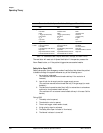
REF 1057983 A Respironics V200 Ventilator Operator’s Manual 7-1
Chapter 7. Operating Theory
Introduction This chapter describes the ventilator’s breath delivery capabilities. It includes
a system overview and descriptions of the ventilation modes and available
breath types. For descriptions of button settings and general operating
instructions, refer to Chapter 8, “Operating Instructions”.
System Overview The ventilator is a microprocessor-controlled ventilator capable of delivering a
mixture of air and oxygen to a patient’s lungs in a predetermined manner to
augment or replace the work normally performed by the patient’s respiratory
system. The ventilator performs breath delivery via two different patient
interfaces:
• endotracheal tube or tracheostomy tube (invasive ventilation)
• face mask, nasal mask, nasal pillows, or mouthpiece with a seal (non-
invasive ventilation)
Ventilator Breath
Types
The ventilator provides the following ventilation breath types:
• Volume Control Ventilation (VCV) – invasive ventilation
• Pressure Control Ventilation (PCV) – invasive ventilation
• Non-Invasive Positive Pressure Ventilation (NPPV) – non-invasive
ventilation
During mechanical ventilation, the operator selects one of the ventilation
modes. The selected ventilation breath type, along with the selected mode, the
patient breathing effort, and the ventilator settings determine the type of
breath delivered. Each ventilation breath type has its own settings, alarms, and
monitor screens. (Refer to Chapter 8, “Operating Instructions”.)
Volume Control Ventilation (VCV)
In Volume Control Ventilation, breaths may be controlled by the ventilator
(mandatory) or triggered by the patient (spontaneous). When controlled by the
ventilator, breaths will be flow controlled and time cycled, thus delivering an
operator (TIDAL VOLUME) set volume. In Volume Control Ventilation, the flow
pattern can be selected between square and descending ramp waveforms.
Refer to Figure 7-1.


















